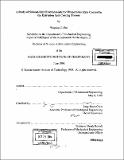| dc.contributor.advisor | Jung-Hoon Chun. | en_US |
| dc.contributor.author | Fan, Winston Chi Hang, 1975- | en_US |
| dc.contributor.other | Massachusetts Institute of Technology. Dept. of Mechanical Engineering. | en_US |
| dc.date.accessioned | 2006-05-15T20:28:07Z | |
| dc.date.available | 2006-05-15T20:28:07Z | |
| dc.date.copyright | 1998 | en_US |
| dc.date.issued | 1998 | en_US |
| dc.identifier.uri | http://hdl.handle.net/1721.1/32761 | |
| dc.description | Thesis (S.B.)--Massachusetts Institute of Technology, Dept. of Mechanical Engineering, 1998. | en_US |
| dc.description | Includes bibliographical references (p. 44). | en_US |
| dc.description.abstract | Microlithography is a process used in microchip fabrication to transfer a circuitry pattern onto a silicon wafer. An important step in the process is the deposition of a thin coating of photoresist from which the lithographic mask is made. The photoresist layer is typically 1 [micro]m thick with a thickness variation of less than 25[angstroms] (within 3[sigma]). The current industrial process of spin coating can achieve these specifications. However, these standards are achieved at the cost of wasting 95% of the photoresist applied. Extrusion-spin coating is a new coating method that has the potential of wasting as little as 50% of the photoresist applied. Before extrusion-spin coating can be used effectively, however, the coating uniformity must be improved through the reduction of solvent evaporation from the wafer surface. This research project evaluates improvements in coating uniformity resulting from the application of a low to moderate solvent concentration environment. At low dispense volumes of approximately 0.5ml, the standard deviation from the mean of the coating thickness was reduced from 335[angstroms] to 56[angstroms] with the application of a low solvent concentration environment. At the highest solvent concentration level that can be achieved by the experimental apparatus, the extrusion-spin coating had a deviation comparable to the high dispense volume, traditional spin coating technique. In addition, the extrusion-spin coating also had an efficiency that was more than a magnitude higher than that of the spin coating. This study indicates that extrusion-spin coating in a solvent-rich environment is a viable replacement for the spin coating process. | en_US |
| dc.description.statementofresponsibility | by Winston C. Fan. | en_US |
| dc.format.extent | 44 p. | en_US |
| dc.format.extent | 2881409 bytes | |
| dc.format.extent | 2881496 bytes | |
| dc.format.mimetype | application/pdf | |
| dc.format.mimetype | application/pdf | |
| dc.language.iso | eng | en_US |
| dc.publisher | Massachusetts Institute of Technology | en_US |
| dc.rights | M.I.T. theses are protected by copyright. They may be viewed from this source for any purpose, but reproduction or distribution in any format is prohibited without written permission. See provided URL for inquiries about permission. | en_US |
| dc.rights.uri | http://dspace.mit.edu/handle/1721.1/7582 | |
| dc.subject | Mechanical Engineering. | en_US |
| dc.title | A study of solvent-rich environments for evaporation rate control in the extrusion spin coating process | en_US |
| dc.type | Thesis | en_US |
| dc.description.degree | S.B. | en_US |
| dc.contributor.department | Massachusetts Institute of Technology. Department of Mechanical Engineering | |
| dc.identifier.oclc | 57569998 | en_US |
